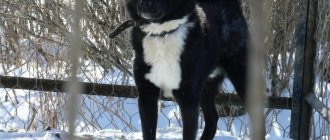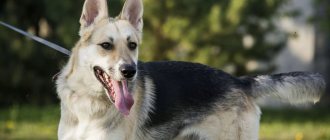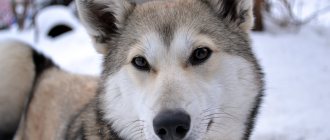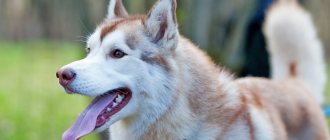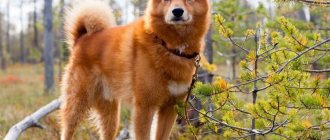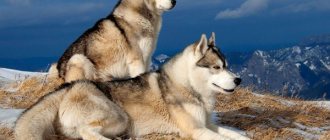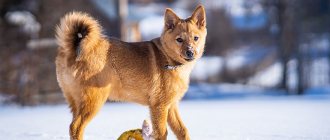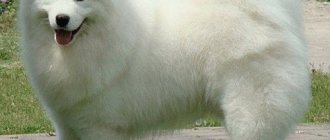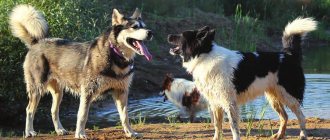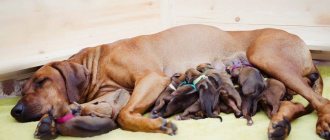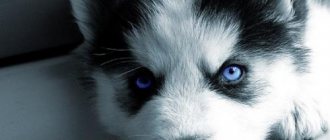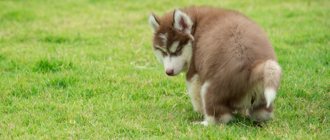The Norwegian Elkhound is a northern Spitz-type dog breed used primarily for moose hunting. Recognized as the national breed of Norway. A wonderful family dog, a companion, strongly attached to family members and the owner, but at the same time remains independent and independent. Hardy and very viscous in work. Also suitable for hunting other large and small animals. Norwegian Elkhounds come in gray and black colors, they are very similar in appearance and character, but are considered separate breeds, each with its own standard.
Origin story
In Scandinavian countries, dogs of the type of the modern Norwegian Elkhound have been known since Viking times. But it cannot be said that they are the ancestors of the Norwegian elk husky. The Norwegian Elkhind was bred based on the hunting dogs that existed at the time, which were selected according to a number of criteria. Breeding activity began at the beginning of the 19th century. The ancient origins of the Elkhound have also been refuted by recent genetic studies conducted by Heidi G. Parker et al. in 2004. According to the study, the Elkhound genetically belongs to the most modern European breeds. The Norwegian Elk Husky was first shown at an exhibition in 1877. At the end of the 19th century, the breed was officially recognized by Swedish and Norwegian kennel clubs. In 1901 a standard was written for the black gray variety. In 1955, the Norwegian Elkhound was recognized by the Federation Cynologique Internationale (FCI).
Hunting use
In Scandinavia, Elkhounds are indispensable for elk hunting. Even the degree of distribution of dogs in different regions depended on the number of these animals.
The Norwegian Elk Husky can work on or off a leash, in a group or alone. Acts independently without a leash. When it detects a moose, it reports its location with a loud bark. Able to hold the animal in place, sometimes chases without losing sight. On a leash, the dog follows the scent silently and leads the hunter straight to the target. The Elkhound works in the hound type. He slowly pursues the beast, very viscous and resilient. Recently, it has shown itself to be excellent as a gun dog when hunting small game, lynx, wolves, and badger.
In their work, Norwegian Elkhounds are very independent, which not every hunter can adapt to.
In addition to hunting, moose huskies can be used for tracking and rescue work. Or get involved in various sports. However, given the low degree of obedience, not every Elkhound can become an agility champion.
Purpose of the breed
The name of the Norwegian Elk Husky breed speaks for itself. These dogs drive an adult moose, bear and other animals and hold them back by barking until the hunter arrives . In addition to baiting large animals, they are used for hunting small game .
In addition to hunting, Norwegian Elkhounds serve as shepherd's assistants , protecting flocks of sheep and other domestic animals from predators. And acute hearing makes dogs vigilant guards and guardians of territory and homes . But above all, they are family favorites and companions.
Appearance
The Norwegian Elkhound is a typical Spitz with a compact short body, erect ears, thick, abundant hair and a tail curled over the back. Sexual dimorphism is well expressed. Height at withers:
- Gray elk husky - 49-52 cm;
- Black moose husky - 43-49 cm.
The skull is wedge-shaped, relatively flat between the ears. The cheekbones are prominent. Stop is expressed moderately. The muzzle tapers gradually towards the black nose. The bridge of the nose is straight. The lips fit well. Scissor bite. The eyes are dark brown, non-protruding. The ears are set straight and high, small, pointed, very mobile. The width of the ears at the base is slightly less than the height.
The body is strong and durable. The topline is straight. The withers are well developed. The back is straight and strong. The croup is wide and strong. The chest is deep, wide, with curved ribs. The underline is almost straight. The tail is set high and relatively short. Screws tightly and sits on the center line of the top without leaning to any side. The legs are strong, strong, straight, and dry. The paws are relatively small, compact, with well-knit and forward-pointing toes.
Black and gray Norwegian Elkhounds look very similar, however they are two different breeds. The black moose husky has a tougher disposition, its coat is shorter, its size is smaller, its body is lighter and less compact.
The coat is medium length, coarse, thick. The guard hair is abundant, without curls. On the front side of the legs and head the hair is smooth and short. Long on the neck, back of the limbs, hips, and tail. The undercoat is soft and dense. Color:
- The gray Elkhound has various shades of gray. Guard hairs with black tips. On the chest, belly, legs, lower part of the tail, under the tail, and on the harness-shaped body, the hair is lighter. From the withers to the elbows, the top of the tail is darkest. The ears and the front of the head (mask) are also dark. A dark line runs from the eyes to the base of the ears. The undercoat is always light gray.
- The black Elkhound has a glossy black color. Small white markings on chest and paws are allowed.
Maintenance and care
The Norwegian Laika is not particularly suitable for a city apartment. She is much better off on the territory of a farm or private home. The dog will certainly notify the owner about the guests with a loud bark. Rarely a city apartment dweller would like such a neighborhood and such a call.
Even the Siberian frost doesn’t matter to the Elkhound, but it doesn’t particularly respect the heat. In hot weather, he needs plenty of fluids and shade to avoid overheating and heatstroke.
A balanced diet should be organized taking into account physical activity. You need to pay special attention to your dog's diet so as not to overfeed it. More than half of it should come from meat: rabbit, turkey, veal and chicken. The diet should also include cereals: buckwheat, millet, rice, as well as raw and boiled vegetables. The dog must somehow replenish energy expenditure. And it should be borne in mind that these dogs are prone to obesity.
You need to walk your dog for a long time , with a sufficient amount of active exercise and mental exercise. The dog will be happy to go jogging with you, even cycling. You can even introduce him to dog sports: agility, white-pulling, skijoring, etc.
His thick coat will have to be brushed every day, and even more often during the molting period.
Character and behavior
The Norwegian Elk Husky is an energetic, affectionate, balanced dog with a strong sense of self-esteem. Blind obedience is unusual for her; the husky is too independent and independent for this. Loves family members very much. She is especially affectionate and friendly to the one she has chosen as her owner. If threatened, it defends its own with a loud bark, but will not attack. Elkhounds treat children well, try to protect children, understand their vulnerability, and tolerate pranks. For older children they will be companions in active games.
While hunting, it can show aggression towards other dogs. With proper upbringing and socialization, they get along well with other pets. At home, as a rule, he behaves quietly.
Character
Despite the harshness of the cold regions of origin, the Norwegian Elkhound is a very affectionate and sensitive dog. At the same time, he is quite independent and independent; in hunting he shows independence and determination. He is characterized by detachment and a desire to manipulate the owner. In the absence of proper upbringing, Norwegian Elkhound dogs can cause inconvenience to humans: they can be difficult to control, disobedient, independent, and react aggressively to other animals.
It is not recommended to have such a dog in families with small children, as it can perceive babies as prey and harm them. But they will get along well with adult children and will even be able to protect them if necessary. In general, Norwegians get along well with other animals, provided they are in the family from infancy.
They have good watchdog qualities, as they react quite warily, and sometimes even hostilely, to the unusual actions of a stranger. When danger arises, they emit a ringing bark, characteristic of this breed, which can serve as a kind of danger signal.
Education and training
The Norwegian Elkhound is very difficult to train. Parenting requires regular work, a certain sensitivity, a lot of patience and understanding. The black Elkhound is considered more docile and more adaptable than the gray Elkhound, although many owners would argue with this.
The level of obedience of the Norwegian husky reindeer is one of its main disadvantages.
Response to commands and feedback is very poor. They reach the required level only at the age of 1.5 years with regular joint work and close contact. But even in this case, one should not expect unquestioning obedience.
Training
Norwegian Huskies are considered quite difficult to train, but this is not due to low intelligence, but because of the stubbornness, independence and complex temperament of the northern dogs.
The owner must have good endurance and patience in the process of training his pet. This is why it is not recommended for inexperienced dog breeders or those who do not have enough time to train to own an Elkahund.
Representatives of this breed, deprived of proper upbringing, can be difficult in life with a person and cause certain inconveniences, try to show willfulness and dominate the owner.
When raising an Elkahund, cynologists recommend being affectionate and caring owners; it is important that the pet feels your love and kindness. At the same time, it is necessary to show firmness and determination.
Content Features
The Norwegian elk husky is not well suited to living in an apartment. The best option is to keep it in the courtyard of a private house. If only because the dog will be able to stretch its legs, and it needs very good physical activity. In this case, it is not necessary to install an aviary; just a booth will be enough. Thick, dense wool protects from bad weather and warms in severe frosts. The Norwegian Elk Husky, unlike many other hunting dogs, does not strive to leave the house in search of adventure; she loves her owner too much and is attached to the territory, which must be protected, at least from the neighbor's cats. Only if you don’t pay attention to the dog at all will it forget its tendency to run away. The Elkhound adapts well to different climates. It works without problems in harsh winter conditions and survives the summer heat with relative ease.
The Norwegian Elk Husky needs very good physical exercise, loves active games in which you can show ingenuity, and often enthusiastically completes search tasks, but its main passion remains hunting.
Care
The Norwegian Elk Husky does not require very complex care. Seasonal shedding is heavy, during which time the dog should be brushed daily to help renew the coat. The rest of the time, shedding is moderate; weekly brushing is sufficient. They bathe only when absolutely necessary, usually 2-3 times a year. Owners also need to monitor the condition of the dog’s ears, eyes and claws.
Description of the nature of the breed
Norwegian Elkhuds have an incredibly cheerful and good-natured disposition . They are balanced and non-aggressive . Therefore, such a pet is not very suitable for apartments . Elkhounds need movement and space .
Pets that were not raised with a dog are treated with some malice. They perceive all family members equally, and treat children with patience, affection and a willingness to support their pranks . The elk husky is smart and quick to learn.
Health and life expectancy
The Norwegian Elk Husky is one of those breeds that rarely suffer from hereditary diseases. The list of these includes:
- Hip dysplasia;
- Ophthalmological diseases (progressive retinal atrophy, cataracts)
- Epilepsy;
- Kidney diseases
- Cysts (usually in adulthood).
Life expectancy is 12-16 years.
There is information about Elkhounds that lived 18 years or more. Mandatory veterinary preventive measures include annual vaccination and regular treatment against parasites. An annual physical examination is recommended.
Brief characteristics of the dog
- Other possible dog names: Norwegian Elkhound, Norsk Elghund, Small Gray Elk Dog, Norwegian Moose Dog.
- Adult height: 49-52 cm.
- Weight: 22-25 kg.
- Characteristic color: all shades of gray, silver.
- Coat length: medium length, thick, hard, with dense undercoat.
- Life expectancy: 12-15 years.
- Advantages of the breed: good-natured, balanced, cheerful, non-aggressive, hardy, gets along with children.
- Difficulties of the breed: willful, stubborn, independent.
- Average price: from $500.
Where to buy a Norwegian Elk puppy
The main population of Norwegian dogs is concentrated in the Scandinavian countries. Elkhounds are very popular in Norway, Sweden, and Finland. There are large nurseries in the CIS countries. In Russia, they mainly breed gray deer huskies. There are an order of magnitude fewer blacks even in our homeland.
Price
Currently, prices for Norwegian Moose Husky puppies vary in a fairly wide range (from 300 to 1000 euros, in rare cases higher). The cost is influenced by the value of the producers, the status of the nursery, working achievements, prospects and compliance with the standard of babies. The Norwegian Laika is sold much cheaper by private breeders, but not all of them approach the issue of breeding responsibly.
Conditions for keeping Yamthunds
Moose husky puppies
Since the breed is considered a working breed, the most suitable conditions for dogs are private houses with a plot, enclosures with the possibility of walking, or service at objects in need of protection. Professional hunters regularly take these assistants into the forest for hunting, where the animals have every opportunity to demonstrate their hunting skills. It is important to understand that it is extremely important for an animal to feel its importance and benefit to its owner. Plus, regular activity provides physical and intellectual exercise, which is important for the stable functioning of the dog. In this case, your furry friend will not have the desire to be mischievous or mischievous.
To summarize, Yamthunds are excellent protectors and undeniably loyal friends. Finding a puppy is not easy, because in our latitudes, breeding of Norwegian huskies began only recently. A Norwegian Husky puppy is bought from Swedish or Norwegian nurseries, but it is important to understand their purpose and the need for active physical activity. In this case, the dogs will grow up to be faithful helpers and strong defenders of their owner.
Maintenance, care, health
The dog should be kept in a spacious house or apartment, where nothing hampers its movements, limiting the space. Of course, if the dog is not kept in a private home, then long walks are indispensable.
Since the pet's fur is abundant and thick, it should be combed every day using a comb with sparse teeth. Wool is not washed as often. As a rule, before the exhibition, after the hunt, or once a month.
The dog is in good health. However, sometimes joint dysplasia occurs, which can be prevented with chondroprotectors.
Historical reference
The true age of the Norwegian Lundehund breed has not been reliably established to date. The first descriptions of similar dogs date back to the 17th century. The initial purpose of the representatives is to hunt puffins (seabirds) in rocky areas. It was from the name of this prey that the name of the breed came - “lunde” means “dead end”, and the second part of the name is translated as “dog”. As shorebirds began to be caught primarily with nets in the 19th century, the need for specialized hunters diminished and their populations declined. Plague also had a negative impact on the breed's numbers, but Lundehunds were restored after World War II and saved from extinction. They are considered part of Norwegian cultural heritage, are not used for their historical purpose and are protected by law.
The breed standard provides an image of the ideal Lundehund.
Recognition by the Scandinavian Kennel Club occurred in 1943. Standard No. 265 and registration in the International Canine Federation system date back to 1965, and today the document in force is the latest edition of 2012. It is impossible to say exactly how much time passed from the appearance of the breed to its official registration, but it is far from one hundred years.
Features of the breed and character of the Elkhound
The existence of this type of animal is confirmed by archaeological excavations from 4000 BC, where the skeleton of a dog was discovered among stone tools. Scientists also found the remains of burials of Viking hunters with weapons and a faithful comrade.
It is believed that the physiological characteristics and character traits of the dog have not changed significantly. Then she had to perform multitasking functions:
- hunt bear, wolf, lynx or small game;
- herd sheep, protect farms and homes.
The name Norwegian Elkhound comes from its special tactics for hunting moose. A brave hunter discovers and drives the game without allowing himself to be attacked, then waits for the owner, holding the elk with his hypnotic bark. Nowadays, wild animals are almost rare in Norway, but the demand for a local dog breed remains relevant.
Working abilities, developed naturally, have created for the Norwegian Elkhound . Physical qualities are determined by a certain natural need.
The compact exterior, strong muscles, and squat format contribute to life on rough terrain. In northern latitudes, endurance is required rather than high speed.
The Elkhound dog is loved not only in Norway. Her strong charm, reliability, ability to adapt to circumstances or conditions, sensitive attitude, lack of nervousness, are valued among fans of the animal world. You need to treat her kindly, but firmly, as with all huskies.
